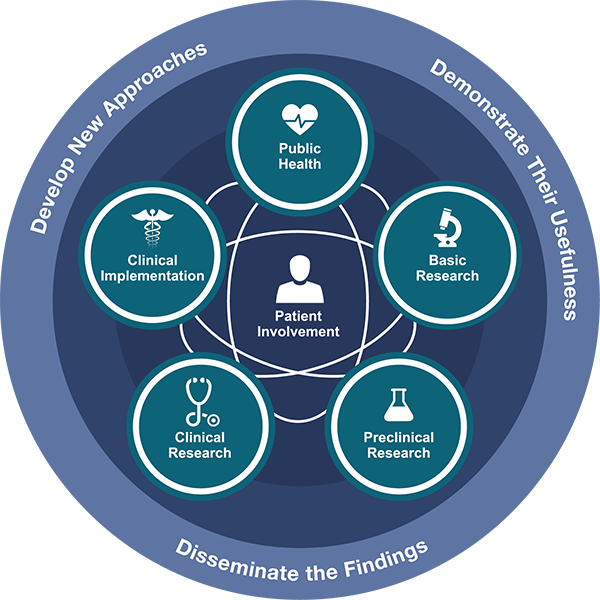Unexpectedly Following a Translational Science Path
February 22, 2022
Former NCATS postbaccalaureate (postbac) fellow Rosita Asawa knew she wanted to be a scientist by middle school.
“I loved reading science books as a child,” said Asawa, now 25, standing in front of her scientific poster on display in the atrium of the Natcher Building on NIH’s Bethesda campus last spring. “I decided somewhere around 7th or 8th grade that I was going to be a scientist.”
After completing an NCATS summer internship in 2016, followed by three years as a fellow, she realized that translational science combines her interests in both medicine and basic research.
“Translational science is the perfect area to be in because I want to have a direct impact both on patients and also on the process of getting treatments to patients,” explained Asawa.
Training and Research Opportunities Abound
NCATS supports training and career development programs that provide important skills, knowledge, perspectives and experiences that are critical for building the translational science workforce. The NCATS postbac program includes a seminar series, professional development opportunities and a strong network of peers and mentors. Interest in NCATS postbac (and postdoctoral) opportunities is growing: The number of NCATS’ postbac fellows has increased from 15 in 2012 to 24 in 2019. Asawa was among 20 fellows who took part in this year’s NCATS Postbac Poster Day.
“Part of the reason I have loved this postbac experience is that it provided the opportunity to talk to so many experts in different fields,” Asawa said. “I’ve asked people about their career paths. I’ve shadowed people, including physician-scientists.”
Asawa’s research interests are wide-ranging. In one project, she investigated new uses of medicines already approved by the U.S. Food and Drug Administration. Many research projects at NCATS focus on studying the use of old drugs in new ways. Asawa worked with researchers at The University of North Carolina at Chapel Hill to identify pediatric drugs that also might be repurposed to treat pediatric cancers. Likewise, in another project (the subject of her poster presentation), she collaborated with scientists at the University of California, Davis, to repurpose compounds for polycystic kidney disease.
In her most recent research project, Asawa and her NCATS colleagues further developed a technique to measure how small molecules or drugs interact with an intended target inside a cell. She spearheaded efforts in the laboratory to determine whether the technology could be useful against a set of proteins with implications for cancer. She was grateful for the opportunity to play an active role in making decisions and moving a project forward.
A New Field to Explore

The translational science spectrum represents each stage of research along the path from the biological basis of health and disease to interventions that improve the health of individuals and the public. (NCATS)
Asawa grew up in Steubenville, Ohio, a small blue-collar town at the Pennsylvania border. Her father is a construction worker, and her mother works in their home. A professor at Asawa’s college, Franciscan University of Steubenville, helped connect Asawa to opportunities at the NIH, including summer internships.
Asawa wasn’t aware of translational science as a field until she came to NCATS and the Division of Preclinical Innovation, which focuses on finding ways to make science faster and more efficient, including speeding up the development of treatments to patients. Asawa recalled, “I hit the ground running and was exposed to technologies at NCATS I had never seen before,” such as high-throughput screening, which entails testing thousands of compounds at once for their biological activity and potential use in therapy.
As she spent more time at NCATS, she wanted to learn more about the entire translational process—not only the preclinical aspects of research. She wanted to see where the process ultimately led and how the work could help patients.
Prolific, Focused and Determined
NCATS research scientist Natalia Martinez, Ph.D., mentored Asawa throughout her three years as a postbac fellow.
“The NCATS postbac program provides students with an incredible opportunity and experience,” she explained. “They are getting exposed to translational science and a research environment—it’s a win for us to have such talented students and a win for them, as it helps their applications to graduate or medical school.”
The numbers indicate the NCATS postbac program has prepared fellows to be successful with their applications to a wide variety of programs. This year, seven fellows are pursuing Ph.D. degrees ranging from organic chemistry to biomedical science to plant pathology. Two fellows are pursuing joint M.D.-Ph.D. programs, while others are attending dental school, medical school and a physician assistant program.
Asawa started an M.D.-Ph.D. program at the University of Maryland this fall. She’s happy with her decision to postpone graduate school until this fall. “One of the main reasons I wanted a postbac was to make sure I still loved science after doing it 40 hours a week. It turned out that I still do.”
Asawa already is a published author, including two papers on which she is first author—a significant honor for any scientist, let alone a postbac fellow. She plans to continue writing research manuscripts from her group’s work at NCATS, even while in school.
Asawa’s advice to others applying to internships or postbac programs? “Try as many different paths as possible and talk to as many people as you can. Take advantage of the opportunity while you are at NIH to explore and ask questions. You never know where your curiosity will take you.”


